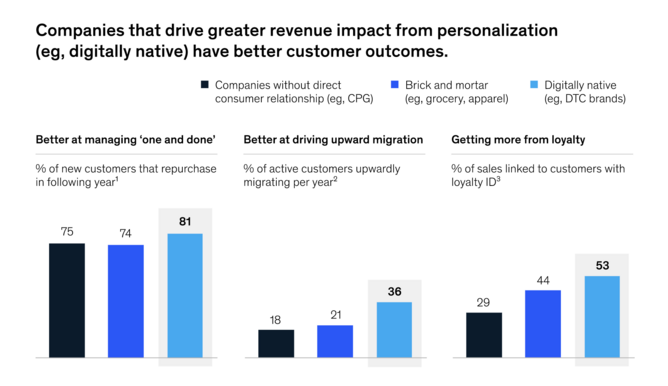McKinsey: Prioritise personalisation for 10-15% revenue lift

Personalisation matters more than ever, with the pandemic and the surge in digital behaviours raising the bar. That’s according to McKinsey’s most recent Next in Personalisation 2021 report, which reveals that companies who excel at demonstrating customer intimacy generate faster rates of revenue growth than their peers.
Personalisation matters more than ever before
The surge in online interactions since the onset of the pandemic has escalated expectations – giving consumers more exposure to the personalisation practices of ecommerce leaders and raising the bar for everyone else. From web to mobile and in-person interactions, consumers now count personalisation as the default standard for engagement.
McKinsey research shows that 71% of consumers expect companies to deliver personalised interactions, and 76% get frustrated when this doesn’t happen. And if consumers don’t like the experience they receive, it’s easier than ever for them to opt out – three-quarters of consumers switched to a new store, product, or buying method during the pandemic.

Shoppers have a strong view on personalisation and reward firms who get it right
Seventy-two percent of shoppers say they expect the businesses they buy from to recognise them as individuals and know their interests. When asked to define personalisation, consumers associate it with positive experiences of being made to feel special. They respond positively when brands demonstrate their investment in the relationship, not just the transaction. Thoughtful touchpoints such as checking in post-purchase, sending a how-to video, or asking consumers to write a review generate positive brand perceptions.
And consumers reward those that get it right. Over three-quarters of consumers (76%) say that receiving personalized communications was a key factor in prompting their consideration of a brand, and 78% say such content made them more likely to repurchase.
Personalisation is especially effective at driving repeat engagement and loyalty over time. Recurring interactions create more data from which brands can design ever-more relevant experiences – creating a flywheel effect that generates strong, long-term customer lifetime value and loyalty.
Performance propels outperformance
Research shows that personalisation most often drives 10-15% revenue lift (with company-specific lift spanning 5-25%, driven by sector and ability to execute). The more skilful a company becomes in applying data to grow customer knowledge and intimacy, the greater the returns. For digitally native companies that forge a data-backed, direct-to-consumer model, personalisation isn’t just how they market, it’s how they operate.
Those leading the charge in personalisation also have better customer outcomes. Their focus on the relationship and long-term value leads to better upward migration, retention, and loyalty.
Personalisation can also be a revenue accelerator even for businesses that typically lack direct access to customers such as companies in the consumer-packaged goods segment. Among these firms, those with the fastest rates of revenue growth were far more likely to prioritise personalisation than slower growers. The research suggests that even small shifts in improving customer intimacy create competitive advantage, and these benefits grow with maturity.

Outperformers organise their business around personalisation
Companies that achieve the best results from personalisation approach it differently. Rather than seeing personalisation simply as a marketing or analytics problem, they view it as an organization-wide opportunity. Rather than focusing solely on short-term wins, they look for long-term drivers of growth and emphasise customer lifetime value.
McKinsey outlines 5 things outperformers can do to accelerate personalisation and create value:
1. They lean into data and analytics to identify opportunities Looking across the customer life cycle, leaders build a granular view of where there is the most value. They leverage customer segments and microsegments, and factor in behavioural, transactional, and engagement trends. They use those insights to define and quantify their personalisation objectives and ground their efforts in customer-centric key performance indicators (KPIs).
2. They invest in rapid activation capabilities powered by advanced analytics Leaders develop at-scale content creation and AI-driven decisioning capabilities so they can respond to customer signals in real-time. They leverage predictive analytics and models to determine what content and messages to serve which customers (for example, propensity models, or predictive next-best-action algorithms). They also establish robust measurement processes that track the impact of customer interventions and feed that information back to their systems and teams. These processes help them deliver the right content through the right channels at the right moments in a consumer’s journey.
3. They invest in fit-for-purpose martech and data Rather than letting a “thousand flowers bloom,” personalisation leaders target a specific set of customer outcomes and use cases that support them. They align organisational resources around these use cases and work back from the desired outcomes to build the data and martech road map and identify the enablers and investments needed to deliver.
4. They commit to an agile operating model Businesses that succeed in scaling personalisation create teams that cut across marketing, product, analytics, and technology, using a hub-and-spoke approach. Each hub owns specific elements of the personalisation journey, with each spoke empowered to build underlying use cases. Together, these teams run hundreds of tests per year, enabled by advanced data analytics and test-and-learn techniques.
5. They invest in talent and training to refine capabilities Leaders bring a similarly data-driven approach to building their teams and organisational capabilities. They focus in on the skills needed to support personalisation at scale (for instance, digital and e-commerce acumen, advanced analytics, product management, or performance marketing). Then they map these capabilities against their current talent base, using the results to inform hiring, training, and upskilling. This approach allows companies to anticipate the expertise and tools they need as their personalisation program advances.
Read McKinsey’s Next in Personalization 2021 Report
- Top 10 ecommerce companies in the USCorporate Finance
- Going global? 5 steps to expanding your ecommerce strategyLeadership & Strategy
- Price value sustainability during inflation – McKinseyLeadership & Strategy
- McKinsey shares 10 rules for business growth in tough timesLeadership & Strategy






